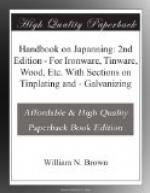wood. The reason for using this coating is that
it effects a considerable saving in the quantity of
varnish used, and because the matter of which the
priming is composed renders the surface of the body
to be varnished uniform, and fills up all pores, cracks,
and other inequalities, and by its use it is easy
after rubbing and water polishing to produce an even
surface on which to apply the varnish. The previous
application of this undercoat was thus an advantage
in the case of coarse, uneven surfaces that it formed
a first and sort of obligatory initial stage in the
process of japanning. This initial coating is
still applied in many instances. But it has its
drawbacks, and these drawbacks are incidental to the
nature of the priming coat which consists of size
and whiting. The coats or layers of japan proper,
that is of varnish and pigment applied over such a
priming coat, will be continually liable to crack
or peel off with any violent shock, and will not last
nearly so long as articles japanned with the same materials
and altogether in the same way but without the undercoat.
This defect may be readily perceived by comparing
goods that have been in use for some time in the japanning
of which an undercoat has been applied with similar
goods in which no such previous coat has been given.
Provided a good japan varnish and appropriate pigments
have been used and the japanning well executed, the
coats of japan applied without a priming never peel
or crack or are in any way damaged except by violence
or shock, or that caused by continual ordinary wear
and tear caused by such constant rubbing as will wear
away the surface of the japan. But japan coats
applied with a priming coat crack and fly off in flakes
at the slightest concussion, at any knock or fall,
more especially at the edges. Those Birmingham
manufacturers who were the first to practise japanning
only on metals on which there was no need for a priming
coat did not of course adopt such a practice.
Moreover, they found it equally unnecessary in the
case of papier-mache and some other goods. Hence
Birmingham japanned goods wear better than those goods
which receive a priming previous to japanning.
Priming or preparing the surface
to be japanned.
The usual priming, where one is applied, consists
of Paris white (levigated whiting) made into a thin
paste with size. The size should be of a consistency
between the common double size and glue, and mixed
with as much Paris white as will give it a good body
so that it will hide the surface on which it is applied.
But in particular work glovers’ or parchment
size instead of common size is used, and this is still
further improved by the addition of one-third of isinglass,
and if the coat be not applied too thickly it will
be much less liable to peel or crack. The surface
should be previously prepared for this priming by
being well cleaned and by being brushed over with hot




